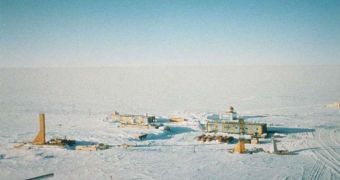More than 26 years after the events took place, scientists are finally confident that they may have found an explanation for the terribly cold temperatures that were recorded on our planet in the winter of 1983. At the time, the Vostok research station, operated by the Soviet Union in Antarctica, recorded a mind-boggling temperature of minus 128.6 degrees Fahrenheit (minus 89 degrees Celsius). This is about 54 degrees Fahrenheit (12 degrees Celsius) colder than the average temperature at that location, and represents a significant spike, LiveScience reports. During that southern hemisphere winter, the station recorded the lowest temperatures ever documented on Earth.
These data were recorded in July 1983, when it was deep winter in the Southern Hemisphere. For about ten days, the mercury in thermometers plunged drastically, making researchers curious as to whether the instruments themselves were not somehow broken or malfunctioning. It was only recently that a collaboration of scientists from the British Antarctic Survey (BAS) and the Arctic and Antarctic Research Institute (AARI), in Russia, managed to provide a satisfactory explanation. The group used computer simulations for the job, as well as a host of satellite datasets and weather charts.
They were in fact attempting to model the future evolution of Antarctica, one of the world's “hot spots” in terms of the influence it exerts on global climate patterns and temperatures. The records the group had of the winter of 1983 showed that the relatively warm air that was usually flowing above the Southern, or Antarctic, Ocean had almost stopped during the exact time frame when the lowest readings ever were recorded. In addition, another current, which was at the time circling Vostok, prevented any type of mixing between warmer air from the ocean and the one above the research station. In other words, that location was given the full benefits to experience the lowest temperature possible.
In addition to these factors, the BAS-AARI group reveals, no cloud covers were present in the skies at the time, according to reports. While intuition may tell you that clouds block sunlight, the truth is that, in the coldest regions of the world, they are actually welcomed. Huge cloud blankets help trap heat in the atmosphere, warming the ground underneath. Zero clouds equal more heat lost in space. Moreover, the experts add, fine clouds of “diamond dust” (ice particles) were suspended in the air, allowing for even more heat to be lost. The combination of these factors led to the extremely low temperatures recorded at the Antarctic outpost, the team concludes.

 14 DAY TRIAL //
14 DAY TRIAL //